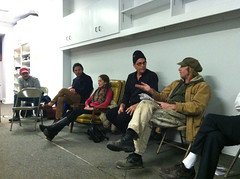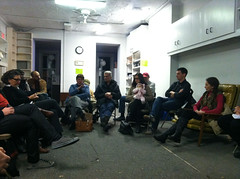An assortment of locals want one of the East Village’s largest vacant buildings to once again host community groups — it’s just unclear whether they have the leverage to force the owner’s hand.
After a discussion on Friday night at Theatre 80, roughly 20 residents decided they would press the owner of the old P.S. 64 building, Gregg Singer, to designate as much as two stories of the six-story building as public space. (On Friday, The Local posted interior shots of the building in its current state, as well as renderings of its potential redevelopment.) The group — still very much in the planning and strategizing phase — leaned towards making one floor a community facility that would be open to anyone living within a boundary to be determined. The other floor would accommodate local groups. To entice Mr. Singer, the coalition would present him with a list of potential tenants for the other floors in his 100-year-old building.
“We are in a deadlock. Nothing’s happening, the building is deteriorating. Let’s start the ball rolling,” said Frank Morales, who helped lead the discussion. “He’s a businessman, so we have to negotiate.”
 Stephen Rex Brown Frank Morales (left) and Dash Hoving (right) discussed the future of the old P.S. 64 building on Friday night.
Stephen Rex Brown Frank Morales (left) and Dash Hoving (right) discussed the future of the old P.S. 64 building on Friday night.Since Mr. Singer purchased the 152,075-square-foot building in 1998, locals have fought him at every turn. Before the purchase, the building, known as Charas/El Bohio, was a space for an eclectic mix of community groups and artists. Mr. Singer evicted the former tenants of the building in 2001, and seven years later proposed building an 19-story dormitory on the property, much to the horror of many in the neighborhood. A legal dispute with the city challenging the building’s landmark status, as well as allegations of behind-the-scenes political wheeling and dealing, prolonged the neglect of the building. The whole debate came to be seen through the prism of gentrification, making it all the more untenable.
On Friday, locals debated how best to encourage Mr. Singer to allow the building to return — at least in part — to its glory days. But it’s unclear how they can force his hand.
“When I think of public space I think of a park. This is a privately owned building,” Mr. Singer said. “It seems what they are looking for is space in a building owned by the government.”
Indeed, the language in the city zoning code leaves a broad definition of “Community Facility Use” — the component in the zoning for the building that would, in theory, reinforce locals’ demands. However, Mr. Singer said there is a major distinction between “community use” and “Community Facility Use” as it is described in the zoning code. The latter would allow for a dormitory, school, medical facility or art gallery among others — all possibilities raised in new promotional material advertising the building.
“We are and have always been open to talking to any potential user for this building,” said Mr. Singer. “The locals need to be open to learning what the law is and understand what uses are allowed.”
 Stephen Rex Brown Community Board 3 District Manager Susan Stetzer (center) also joined the discussion.
Stephen Rex Brown Community Board 3 District Manager Susan Stetzer (center) also joined the discussion.One attendee at Friday’s meeting was skeptical of any serious discussions between the two parties that have long been at odds. “What’s the point of this meeting? We’re discussing someone else’s property,” said Dash Hoving, a painter who has recently done some work on the old P.S. 64 building for Mr. Singer. “The building needs at least a $25-million renovation, and a tenant won’t pay for it if he has to move in with yesterday’s baggage.”
Other attendees favored leaving the decade-long struggle behind, as well.
“We ought to come up with a rational plan that splits the use of the building into two parts,” said Eric Rassi, who called the meeting. “Let’s drop the old stuff with Singer, let’s make it a brand new initiative.”




